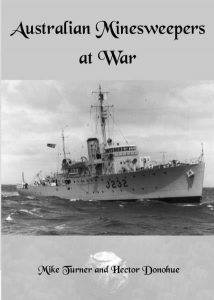- Author
- Book reviewer
- Subjects
- Ship design and development, History - WW2, Book reviews
- Tags
-
- RAN Ships
- None noted.
- Publication
- September 2018 edition of the Naval Historical Review (all rights reserved)
Published by the Sea Power Centre, Canberra, 2018. Paperback of 328 pages with numerous black & white illustrations, portraits, tables and maps. The first edition of this publication was sold out and another run or online option is contemplated.

Mike Turner spent most of his working life with the RAN Experimental Laboratory, developing a vast knowledge of most aspects of mine warfare. He retired in 1990 as a Principal Research Scientist and became an industry consultant. Mike has published extensively on the theory behind MCM operations. After joining the RAN Hector Donohue sub-specialised in Clearance Diving and ASW. During his career he undertook an exchange posting with the RN as a Squadron MCM officer and commanded HMA Ships Yarra and Darwin, attaining the rank of Commodore before retiring in 1991. He joined Australian Defence Industries involved in the international sales of Australian designed minesweeping systems. These two men with a lifetime of MCM theoretical and practical experience have combined well in producing an excellent consolidation of mine warfare operations conducted by the RAN during two world wars.
We are reminded that mines laid by a German commerce raider off southeast Victoria in July 1917 fatally damaged a British steamship and, that the first casualties caused by enemy action on Australian soil during WWII were two sailors killed in July 1941 when attempting to render safe an enemy mine off the South Australian coast.
The vast scope of mine warfare on a world-wide scale is addressed with an estimated 700,000 mines laid in WWII which sank about 2,000 ships. Closer to home the coastal ship Bungareewas requisitioned into the RAN in October 1940 for conversion into a minelayer. She laid her first defensive mine field off the coast of New Guinea in August 1941 and continued in these operations around the Australian coastline and into the Pacific until December 1943. HMAS Bungareecould carry up to 467 mines and during her career laid over 9,000 mines. The authors also acknowledge the contribution made by the RAAF in Allied operations in laying mines throughout the Pacific theatre. After sowing these vast quantities of mines, comes the armistice, and another enormous task arose in sweeping them and making the sea lanes once more secure for safe navigation.
The role played by a great number of small ships and the men involved in mine warfare is covered in detail. This includes ships built for minesweeping duties and the large number of small ships requisitioned for similar duties. It took a long time to establish a mine warfare branch during WWI with a small number of vessels involved. However, in WWII the reaction was more positive with the early acquisition of the minelayer Bungaree, plus Bathurst-class minesweepers/corvettes built quickly in eight shipyards, and auxiliary mine warfare vessels, mostly requisitioned fishing vessels. Of these 92 ships, seven vessels were sunk, with extensive loss of life but only one was directly related to mine warfare operations, when HMAS Warrnambool,swept a mine which exploded under her hull and sank the vessel, with a number of injuries and four fatalities.
A number of RAN personnel served in the European theatre during WWII of which ten volunteered for the hazardous Bomb and Mine Disposal operations. This cohort performed truly remarkable tasks in rendering enemy mines safe. Some became the most highly decorated Australian naval personnel of the war. All four George Crosses and eight of the nine George Medals awarded to the RAN during WWII concerned those involved in these BMD operations.
Australian Minesweepers at War is possibly the most comprehensive volume of its type now available. While this volume mostly covers the period of two world wars, the post war clearance of explosive ordnance continues, especially in the Pacific Islands, to this day. Its detailed descriptions and technical knowledge is a great credit to the authors and it is both interesting, covering a critical aspect of naval history, and an important book of reference.
Reviewed by Trebor




